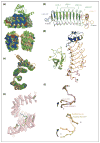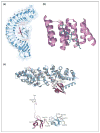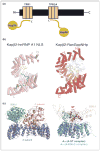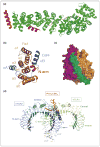Ligand binding by repeat proteins: natural and designed
- PMID: 18602006
- PMCID: PMC3500881
- DOI: 10.1016/j.sbi.2008.05.008
Ligand binding by repeat proteins: natural and designed
Abstract
Repeat proteins contain tandem arrays of small structural motifs. As a consequence of this architecture, they adopt non-globular, extended structures that present large, highly specific surfaces for ligand binding. Here we discuss recent advances toward understanding the functional role of this unique modular architecture. We showcase specific examples of natural repeat proteins interacting with diverse ligands and also present examples of designed repeat protein-ligand interactions.
Figures




References
-
- Magliery TJ, Regan L. Beyond consensus: statistical free energies reveal hidden interactions in the design of a TPR motif. J Mol Biol. 2004;343:731–745. - PubMed
-
- Kim HM, Oh SC, Lim KJ, Kasamatsu J, Heo JY, Park BS, Lee H, Yoo OJ, Kasahara M, Lee JO. Structural diversity of the hagfish variable lymphocyte receptors. J Biol Chem. 2007;282:6726–6732. Inserting multiple LRR repeats from a germline repertoire to accomplish diversity. - PubMed
Publication types
MeSH terms
Substances
Grants and funding
LinkOut - more resources
Full Text Sources
Other Literature Sources
Research Materials

